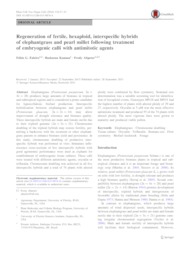Regeneration of fertile, hexaploid, interspecific hybrids of elephantgrass and pearl millet following treatment of embryogenic calli with antimitotic agents.
Regeneration of fertile, hexaploid, interspecific hybrids of elephantgrass and pearl millet following treatment of embryogenic calli with antimitotic agents.
Author(s): FALEIRO, F. G.; KANNAN, B.; ALTPETER, F.
Summary: Abstract: Elephantgrass (Pennisetum purpureum, 2n = 4x = 28) produces large amounts of biomass in tropical and subtropical regions and is considered a prime candidate for lignocellulosic biofuel production. Interspecific hybridization between elephantgrass and pearl millet (Pennisetum glaucum, 2n = 2x = 14) may allow improvement of drought tolerance and biomass quality. These interspecific hybrids are male and female sterile due to their triploid genome (2n = 3x = 21). Chromosome doubling of the triploid hybrids may restore fertility, permitting a backcross with the recurrent or other elephantgrass parents to enhance biomass yield and persistence. In this study, chromosome doubling of productive interspecific hybrids was performed in vitro. Immature inflorescence cross-sections of five interspecific hybrids with good agronomic performance were used as explants for establishment of embryogenic tissue cultures. These calli were treated with different antimitotic agents, oryzalin or trifluralin. Chromosome doubling was achieved in all five interspecific hybrids and a total of 74 plants with altered ploidy were confirmed by flow cytometry. Stomatal size determination was a suitable screening tool for identification of hexaploid events. Genotypes MN18 and MN51 had the highest number of plants with altered ploidy of 29 and 27, respectively. Oryzalin at 5 µM was the most effective antimitotic treatment and produced 55 of the 74 plants with altered ploidy. The most vigorous lines were grown to maturity and produced viable pollen.
Publication year: 2016
Types of publication: Journal article
Unit: Embrapa Cerrados
Observation
Some of Embrapa's publications are published as ePub files. To read them, use or download one of the following free software options to your computer or mobile device. Android: Google Play Books; IOS: iBooks; Windows and Linux: Calibre.
Access other publications
Access the Agricultural Research Database (BDPA) to consult Embrapa's full library collection and records.
Visit Embrapa Bookstore to purchase books and other publications sold by Embrapa.

